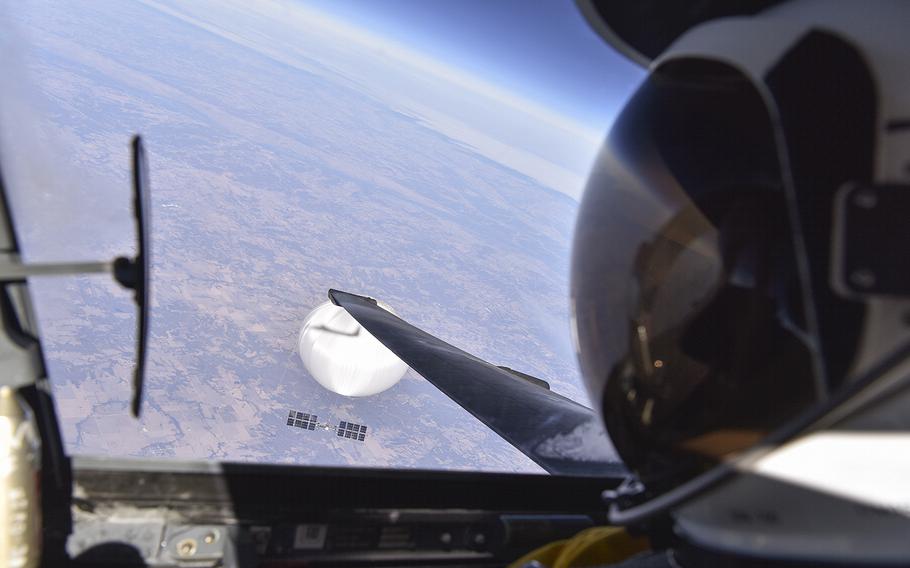
An Air Force pilot looks down at the suspected Chinese surveillance balloon as it hovered over the central continental United States on Feb. 3, 2023. Recovery efforts began shortly after the balloon was shot down Feb. 4 by a U.S. fighter jet over waters off the coast of South Carolina. (Defense Department)
WASHINGTON — Search crews have recovered most of the Chinese surveillance balloon and its large payload from waters off the coast of South Carolina, the Pentagon said Wednesday as it provided a new photo of the airship taken from a U.S. spy plane.
The balloon was shot down Feb. 4 after it spent several days crossing the United States at about 60,000 feet, which military officials felt was high enough not to pose a danger to civilian air traffic. Once it got over the Atlantic Ocean — and there was no longer a danger to people and property on the ground — a fighter jet shot it down.
Navy and Coast Guard crews spent days scouring a debris field in the ocean about the size of 15 football fields recovering balloon wreckage.
“The majority of the balloon, including the payload, was recovered,” said Sabrina Singh, the Pentagon’s deputy press secretary.
The balloon’s payload was described as the size of about three full-size buses and included solar panels, surveillance cameras, sensors and other tools. Officials have said the balloon was 200 feet tall and was able to propel itself.
Singh told reporters at the Pentagon that the wreckage is now being examined by the FBI and confirmed an Air Force U2 spy plane was sent up to examine the balloon when it was over U.S. territory and took at least one photo of the airship.
The shootdown of the balloon touched off a wave of new concern this month among Americans about possible spy ships hovering over U.S. soil, and was followed by three additional shootdowns of other objects that, at about 45,000 feet, the Pentagon felt were threats to civilian air traffic. U.S. fighter jets shot down those objects on Feb. 10, Feb. 11 and Feb. 12 in Alaska, Canada’s Yukon territory and Lake Huron near Michigan, respectively.
U.S. officials, however, have yet to disclose many details about those three “high-altitude objects.”
“These were commercial, we believe,” Singh said. “We do not believe these to be [from] any type of foreign entity. We have not been able to recover all the debris from where these were shot down, so we just don’t have much more information at this time.”
The Pentagon also expressed greater concern about China’s intentions when it comes to the war in Ukraine. Earlier in the day, Russian President Vladimir Putin met with a top Chinese diplomat in Moscow and the two celebrated what they called “new milestones” in Chinese-Russian relations. Beijing, so far, has yet to condemn Russia for the war in Ukraine — and instead has repeatedly said it prefers to resolve the conflict diplomatically.
Singh said Wednesday that there will “be consequences for China” if the Chinese give weapons or equipment to Russia to use against Ukraine.
“We haven’t seen [China] give lethal aid to Russia, at this time, for the war, but they also haven’t taken that off the table,” she said.
Friday will mark the one-year anniversary of Russia’s invasion of Ukraine, and Putin has given no indication that he’s ready to end it. Despite Moscow’s military failures and the deaths of almost 200,000 Russian troops in the past 12 months, according to U.S. and other Western estimates, Putin has insisted Russia’s attack on Ukraine will continue.
The United States has committed $30 billion worth of weapons and other military aid to help Ukraine defend its land against Russian forces. Still, Singh said the U.S. is trying to keep lines of communication with Russia open and stressed any resolution of the war would have to include Ukraine.
“Russia has done this to themselves,” she said. “We are not at war with Russia. We are not fighting with Russia. We are supporting the Ukrainians in their war that Russia started. … Nothing is going to happen with Ukraine without Ukraine at the table, as well.”